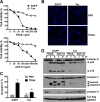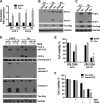Human T-cell leukemia virus type 1 Tax-deregulated autophagy pathway and c-FLIP expression contribute to resistance against death receptor-mediated apoptosis
- PMID: 24352466
- PMCID: PMC3958099
- DOI: 10.1128/JVI.03025-13
Human T-cell leukemia virus type 1 Tax-deregulated autophagy pathway and c-FLIP expression contribute to resistance against death receptor-mediated apoptosis
Abstract
The human T-cell leukemia virus type 1 (HTLV-1) Tax protein is considered to play a central role in the process that leads to adult T-cell leukemia/lymphoma (ATL) and HTLV-1-associated myelopathy/tropical spastic paraparesis (HAM/TSP). HTLV-1 Tax-expressing cells show resistance to apoptosis induced by Fas ligand (FasL) and tumor necrosis factor (TNF)-related apoptosis-inducing ligand (TRAIL). The regulation of Tax on the autophagy pathway in HeLa cells and peripheral T cells was recently reported, but the function and underlying molecular mechanism of the Tax-regulated autophagy are not yet well defined. Here, we report that HTLV-1 Tax deregulates the autophagy pathway, which plays a protective role during the death receptor (DR)-mediated apoptosis of human U251 astroglioma cells. The cellular FLICE-inhibitory protein (c-FLIP), which is upregulated by Tax, also contributes to the resistance against DR-mediated apoptosis. Both Tax-induced autophagy and Tax-induced c-FLIP expression require Tax-induced activation of IκB kinases (IKK). Furthermore, Tax-induced c-FLIP expression is regulated through the Tax-IKK-NF-κB signaling pathway, whereas Tax-triggered autophagy depends on the activation of IKK but not the activation of NF-κB. In addition, DR-mediated apoptosis is correlated with the degradation of Tax, which can be facilitated by the inhibitors of autophagy.
Importance: Our study reveals that Tax-deregulated autophagy is a protective mechanism for DR-mediated apoptosis. The molecular mechanism of Tax-induced autophagy is also illuminated, which is different from Tax-increased c-FLIP. Tax can be degraded via manipulation of autophagy and TRAIL-induced apoptosis. These results outline a complex regulatory network between and among apoptosis, autophagy, and Tax and also present evidence that autophagy represents a new possible target for therapeutic intervention for the HTVL-1 related diseases.
Figures







References
-
- Osame M, Usuku K, Izumo S, Ijichi N, Amitani H, Igata A, Matsumoto M, Tara M. 1986. HTLV-I associated myelopathy, a new clinical entity. Lancet i:1031–1032 - PubMed
-
- Goncalves DU, Proietti FA, Barbosa-Stancioli EF, Martins ML, Ribas JG, Martins-Filho OA, Teixeira-Carvalho A, Peruhype-Magalhaes V, Carneiro-Proietti AB. 2008. HTLV-1-associated myelopathy/tropical spastic paraparesis (HAM/TSP) inflammatory network. Inflamm. Allergy Drug Targets 7:98–107. 10.2174/187152808785107642 - DOI - PubMed
Publication types
MeSH terms
Substances
LinkOut - more resources
Full Text Sources
Other Literature Sources
Research Materials
Miscellaneous

